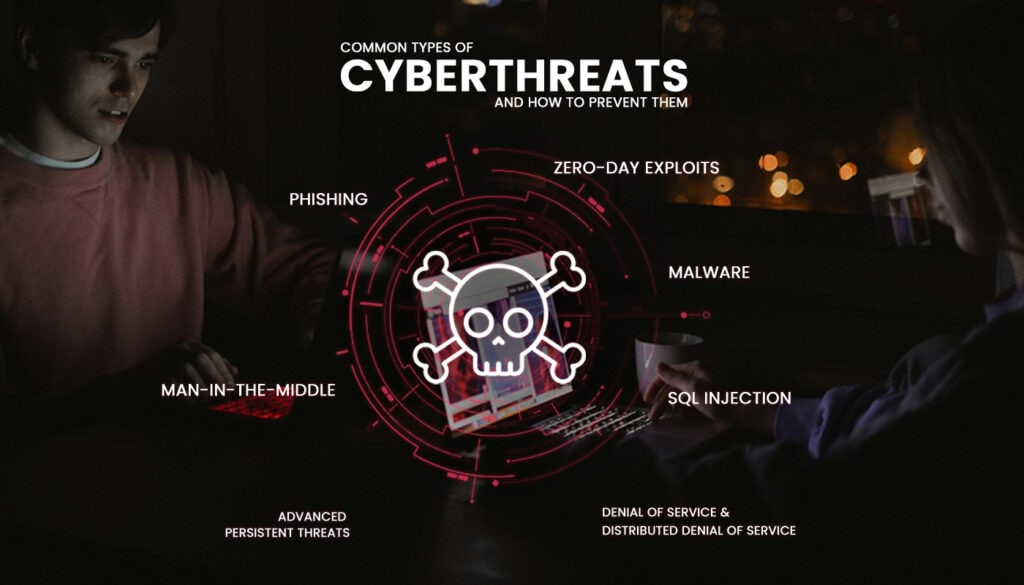- 08/10/2024
- by Miguel Sabater
Cyberthreats Common Types

Introduction
Cyberthreats are a significant and growing concern in the modern digital landscape. With the increasing reliance on technology for personal, professional, and government functions, the potential damage from cyberthreats has never been greater. Understanding these threats is essential for protecting sensitive information, ensuring the integrity of digital infrastructures, and protecting individuals and organizations from malicious attacks.
Types and Categories
Malware
Malware, short for malicious software, is a broad category of software designed to damage, disrupt, or gain unauthorized access to computer systems. It comes in various forms, each with distinct characteristics and methods of operation.
- Viruses Viruses attach themselves to legitimate programs and spread when the infected program is executed. They can delete files, corrupt data, and disrupt system operations.
- Worms Unlike viruses, worms do not require host programs to spread. They replicate themselves across networks, causing significant damage by consuming bandwidth and overloading systems.
- Trojans Named after the Trojan Horse from Greek mythology, these programs disguise themselves as legitimate software but contain malicious code that executes once installed.
- Ransomware Ransomware encrypts a victim’s files and demands a ransom for the decryption key. It has become increasingly sophisticated and targets individuals and organizations alike.
- Spyware Spyware secretly monitors user activities and collects information without their knowledge, often used for stealing personal information or spying on users.
- Adware Adware displays unwanted advertisements on the user’s device. While not always harmful, it can be intrusive and degrade system performance.
Phishing
Phishing is a social engineering attack that tricks individuals into providing sensitive information, such as usernames, passwords, and credit card details, by masquerading as a trustworthy entity.
- Email Phishing Attackers send emails that appear to be from legitimate sources, prompting recipients to click on malicious links or provide personal information.
- Spear Phishing More targeted than general phishing, spear phishing involves personalized attacks aimed at specific individuals or organizations.
- Whaling Whaling targets high-profile individuals like executives or public figures, often using carefully crafted messages to deceive the target.
- Smishing Smishing, or SMS phishing, involves sending fraudulent text messages to trick recipients into divulging personal information or clicking on malicious links.
- Vishing Vishing, or voice phishing, uses phone calls to impersonate legitimate entities and extract sensitive information from victims.
Denial of Service (DoS) and Distributed Denial of Service (DDoS)
These attacks aim to make a system or network resource unavailable to users by overwhelming it with traffic.
- Network-level DoS This type of attack targets the network infrastructure and flooding it with traffic and causing network congestion.
- Application-level DoS These attacks focus on disturbing specific applications, overwhelming them with requests to cause service disruptions.
- Botnets Botnets are networks of infected computers controlled by an attacker to launch large-scale DDoS attacks, often used to bring down websites and online services.
Man-in-the-Middle (MitM) Attacks
MitM attacks occur when an attacker intercepts and manipulates communication between two parties without their knowledge.
- Eavesdropping Attackers secretly listen to private conversations or data transmissions, and collect sensitive information.
- Session Hijacking This involves taking control of a user’s session, often by stealing session cookies, allowing the attacker to impersonate the user.
- SSL Stripping Attackers downgrade secure HTTPS connections to unsecure HTTP, making it easier to intercept and manipulate communications.
SQL Injection
SQL injection attacks target web applications by injecting malicious SQL code into query fields, allowing attackers to manipulate databases and access sensitive information.
Cross-Site Scripting (XSS)
XSS attacks involve injecting malicious scripts into web pages viewed by other users, potentially stealing session cookies, defacing websites, or redirecting users to malicious sites.
Zero-Day Exploits
Zero-day exploits target vulnerabilities in software that are unknown to the vendor. These exploits are particularly dangerous because there are no existing defenses against them until the vendor becomes aware and issues a patch.
Advanced Persistent Threats (APTs)
APTs are prolonged and targeted cyberattacks where attackers gain unauthorized access to a network and remain undetected for an extended period, often stealing sensitive data.
Insider Threats
Insider threats come from within the organization, where employees, contractors, or partners misuse their access to harm the organization, either on purpose or unintentionally.
Symptoms and Signs
Unexpected System Behavior
Unexplained changes in system behavior, such as programs crashing, files disappearing, or unusual error messages, can indicate a cyber threat.
Slow Performance
Malware and other cyberthreats can significantly slow down system performance as they consume resources, making it difficult for legitimate applications to function properly.
Frequent Crashes
Systems infected with malware or under attack may experience frequent crashes or reboots, disrupting normal operations.
Unusual Network Activity
Unexpected spikes in network traffic, unknown connections, or large data transfers can be signs of cyberthreats such as DDoS attacks or data exfiltration.
Unauthorized Access Attempts
Repeated login attempts, unfamiliar devices accessing the network, or unauthorized changes to system settings can indicate a cyberthreat.
Causes and Risk Factors
Human Error
Human error is one of the leading causes of cyberthreats. Employees may fall victim to phishing attacks, use weak passwords, or inadvertently expose sensitive information.
Outdated Software
Outdated software often contains vulnerabilities that can be exploited by attackers. Regular updates and patches are essential to maintain security.
Weak Passwords
Using weak or easy passwords increases the risk of unauthorized access. Implementing strong password policies is crucial for security.
Lack of Awareness
A lack of cybersecurity awareness among employees can lead to risky behaviors, such as clicking on malicious links or failing to recognize phishing attempts.
Insufficient Security Measures
Inadequate security measures, such as lack of firewalls, antivirus software, or encryption, make systems more vulnerable to cyberthreats.
Diagnosis and Tests
Security Audits
Regular security audits help identify vulnerabilities and weaknesses in an organization’s cybersecurity posture, allowing for timely remediation.
Penetration Testing
Penetration testing involves simulating cyberattacks to test the effectiveness of security measures and identify potential points of entry for attackers.
Vulnerability Scanning
Automated vulnerability scanning tools can identify known weakness in systems and applications, enabling organizations to address them quickly.
Network Monitoring
Continuous network monitoring helps detect unusual activity and potential cyberthreats in real time, allowing for swift response.
Log Analysis
Analyzing system logs can reveal signs of cyberthreats, such as unauthorized access attempts, changes in system settings, or unusual patterns of behavior.
Treatment Options
Antivirus Software
Antivirus software detects and removes malware from systems, providing a first line of defense against many types of cyberthreats.
Firewalls
Firewalls act as barriers between trusted and suspicious networks, controlling incoming and outgoing traffic based on predetermined security rules.
Intrusion Detection Systems (IDS)
IDS monitor network traffic for suspicious activity and alert administrators to potential security incidents.
Patch Management
Regularly applying patches and updates to software and systems helps close security vulnerabilities and protect against exploits.
Employee Training
Training employees on cybersecurity best practices, such as recognizing phishing attempts and using strong passwords, can significantly reduce the risk of cyber threats.
Preventive Measures
Regular Updates and Patching
Keeping software and systems up to date with the latest patches helps protect against known vulnerabilities and exploits.
Strong Password Policies
Implementing strong password policies, such as using complex passwords and regular changes, enhances security.
Two-Factor Authentication
Two-factor authentication adds an extra layer of security by requiring a second form of verification in addition to a password.
Data Encryption
Encrypting sensitive data ensures that even if it is intercepted, it cannot be read without the decryption key.
Security Awareness Training
Regular training sessions on cybersecurity best practices help employees stay informed about the latest threats and how to avoid them.
Advice on Best Practices
Experts recommend implementing multi-layered security approaches, including regular updates, strong password policies, and continuous monitoring, to protect against a wide range of cyber threats.
Conclusion
Cyberthreats pose a significant risk to individuals and organizations alike. By understanding the various types of threats, recognizing the symptoms, and implementing strong security measures, it is possible to prevent these risks effectively. Continuous education and staying alert are key to staying ahead of cybercriminals and protecting sensitive information in an increasingly digital world.
Ready to elevate your cybersecurity?
Don’t leave your business vulnerable to cyberthreats. With Trucell’s expertise and partnership with SentinelOne, you can ensure strong protection for your network, data, and system.
Take the step in securing your business today!




Comments (16)
How to Prevent Phishing attacks - Trucell
10/10/2024 - 1:42 pm[…] attacks are a growing concern, posing significant threats to both individuals and organizations. These attacks aim to deceive victims into providing […]
cougar mounts
05/02/2025 - 10:23 am… [Trackback]
[…] Find More here to that Topic: trucell.com.au/blog/cyberthreats-common-types/ […]
เว็บซื้อหวย 24 สมัครเข้าใช้งานฟรี แทงได้ไม่มีอั้น
14/02/2025 - 10:32 am… [Trackback]
[…] There you can find 17112 more Information to that Topic: trucell.com.au/blog/cyberthreats-common-types/ […]
โกดังเช่า ราคาถูก
17/02/2025 - 11:48 am… [Trackback]
[…] Read More here to that Topic: trucell.com.au/blog/cyberthreats-common-types/ […]
Learn more
19/02/2025 - 6:39 am… [Trackback]
[…] Info on that Topic: trucell.com.au/blog/cyberthreats-common-types/ […]
อยากเริ่มต้นธุรกิจ นำเข้าสินค้าจากจีน
21/02/2025 - 3:53 pm… [Trackback]
[…] Info to that Topic: trucell.com.au/blog/cyberthreats-common-types/ […]
ยางไดอะแฟรม
25/02/2025 - 11:39 am… [Trackback]
[…] There you will find 50928 additional Info to that Topic: trucell.com.au/blog/cyberthreats-common-types/ […]
couples massage
26/02/2025 - 4:37 pm… [Trackback]
[…] Find More here to that Topic: trucell.com.au/blog/cyberthreats-common-types/ […]
จองตั๋วรถทัวร์นครชัยแอร์
27/02/2025 - 2:19 pm… [Trackback]
[…] Find More Info here on that Topic: trucell.com.au/blog/cyberthreats-common-types/ […]
lion191win เว็บพนันมาแรง
03/03/2025 - 11:26 am… [Trackback]
[…] Info on that Topic: trucell.com.au/blog/cyberthreats-common-types/ […]
https://misangel.com/2025/03/02/pocket-option-candlestick-takeover-strategija-dlja/
12/03/2025 - 3:54 am… [Trackback]
[…] Read More here on that Topic: trucell.com.au/blog/cyberthreats-common-types/ […]
https://otthonplusz-expo.hu/nyitolap/2025/03/02/everything-you-need-to-know-about-pocket-option/
12/03/2025 - 4:14 am… [Trackback]
[…] Find More on that Topic: trucell.com.au/blog/cyberthreats-common-types/ […]
y2k168
13/03/2025 - 10:17 pm… [Trackback]
[…] Find More Information here to that Topic: trucell.com.au/blog/cyberthreats-common-types/ […]
Relax Gaming Demo
25/03/2025 - 11:27 am… [Trackback]
[…] Find More Info here to that Topic: trucell.com.au/blog/cyberthreats-common-types/ […]
Dragon Hatch 2
28/03/2025 - 1:30 pm… [Trackback]
[…] Find More on that Topic: trucell.com.au/blog/cyberthreats-common-types/ […]
push888
30/03/2025 - 12:37 pm… [Trackback]
[…] Info to that Topic: trucell.com.au/blog/cyberthreats-common-types/ […]